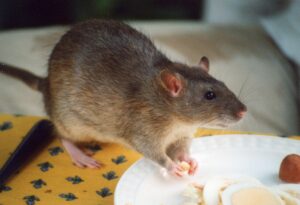Have you ever been woken up in the middle of the night by the sound of scurrying little feet? Or maybe you’ve found chewed up food packaging in your pantry, or worse yet, seen a rat dart across your kitchen floor?
If you’re like most homeowners, the thought of a rat infestation is enough to send shivers down your spine.
But what if there was a simple and effective way to get rid of these pesky rodents without resorting to toxic chemicals or expensive exterminators?
Enter baking soda – the household ingredient that just might be the answer to your rat problem.
In this blog post, we’ll explore the science behind using baking soda to kill rats, how to use it effectively, and whether or not it’s a safe and humane solution for getting rid of these unwanted guests.
Below are the answers you’ll need concerning baking soda and rats.
Can You Kill Rats With Baking Soda?

Yes, you can kill rats using baking soda, but they must ingest 2 to 3 grams of this substance to die. Moreover, they must take it in a single sitting, and since baking soda isn’t rats’ favorite meal, consuming 2 to 3 grams at a go seems improbable.
Nonetheless, if they do, the baking soda will react with the stomach acids producing carbon dioxide.
Since rats cannot pass gas or burp, this gas will build up in the rat’s system, eventually causing a blockage or rapture that kills it.
While baking soda can kill rats, this method is inhumane, and there are no guarantees it will work. Remember, rats can develop resistance or immunity to different poisons, including baking soda.
Therefore, the rats in your home can continue living and wreaking havoc after ingesting baking soda.
The alkaline nature of baking soda isn’t great for a rat’s mouth, turning it alkaline and burning the tongue and lips.
Although baking soda can help eliminate rats in your home, you cannot kill all the rats using this method because not all the rats will consume it.
Around half the rat population in your property will consume it, leaving you with other rats to deal with. Although you must reapply baking soda or use a different eradication method like live traps, your work will be much easier.
What Can I Mix Baking Soda With To Kill Rats?
Since rats do not enjoy eating baking soda, you must combine it with something else to entice them enough to consume it.
Create a practical baking soda-based rat killer using these ingredients.
1. Baking Soda and Chocolate Cake Mix
Like most of us, rats enjoy the taste of chocolate, so why not mix chocolate cake mix with baking soda and use the mixture to kill these rodents?
After all, they will happily eat it. The best part is you don’t have to purchase or bake a chocolate cake; cake mix will do.
Mix baking soda and chocolate cake mix in a 1:1 ratio in a shallow bowl. You can use this rat killer in its dry form, provided you leave another bowl with water next to it so the rats can drink after consuming the mix.
Alternatively, create a thick paste by adding water to the mix gradually while stirring.
Leave the bowl containing this homemade rat killer at spots rats frequent for a couple of days to give the rodents ample time to feel comfortable enough to eat it.
2. Baking Soda, Flour, Chocolate, and Sugar
These ingredients develop a dough rats will find enticing. Use flour of any kind, fine castor sugar or standard white sugar, and chocolate sprinkles or powder.
Combine equal portions of baking soda, flour, and sugar in a bowl, add a few chocolate sprinkles or powder for additional flavor, then combine the mixture properly.
You don’t have to use chocolate, but doing so will make the bait more attractive.
Next, add water gradually while stirring until you form a relatively firm dough. Transfer a few teaspoons of the mixture into tiny disposable saucers and place them strategically in different areas.
3. Baking Soda and Peanut Butter
Rodents love peanut butter; that’s why it is commonly used as bait in rodent traps. This food is sweet, has a robust scent, and contains proteins, oils, and fats.
Mix equal proportions of baking soda and peanut butter in a tiny bowl and transfer small portions into disposable saucers. After that, spread them in different parts of your home.
How To Kill Rats With Baking Soda
As mentioned earlier, rats must eat enough baking soda to die. However, they must ingest it at more than 50% concentration.
In addition, positioning is critical because strategically placing the baking soda bait increases the chances of rats consuming them.
Therefore, after creating the bait using baking soda and substances rats love eating, choose the best places to leave the containers with bait.
Despite having poor vision, rats are exceptionally cautious, so they stay away from open places and tend to move to and from various places through ‘rodent runs’ like walls.
Position the baits along the ‘rodent runs,’ keeping them 2 meters apart. Rats also dislike the human scent, so wear the containers to remove the human scent and put on gloves before touching the container for your rat bait.
Put the baking soda-based rat killer in places with active rat activity, such as around garbage bins and dark, unused parts of your home like the attic.
How Quickly Does Baking Soda Kill Rats?
Rats die within 24-36 hours after ingesting baking soda. However, in that time, the rodents may move around, dying in different places or making their way back to where they consumed the baking soda.
Can Baking Soda Alone Kill Rats?
You can kill rats with only baking soda if they eat the needed amounts (2 to 3 grams). Also, you’ll need to mix baking soda with other things to create a bait these rodents will eat because using baking soda alone won’t work because the rats will not eat it. Therefore, mix it with chocolate, sugar, peanut butter, or other things.
Summary
Baking soda can kill rats, but it is not a foolproof method. Its effectiveness relies on different variations, including the amount consumed and the rat’s tolerance to baking soda. Nonetheless, this method is easy to use, inexpensive and safe.

I’m Mike Hyle, an exterminator with 7+ years of experience handling all sorts of pests, including mice, cockroaches, bed bugs, and termites. I also write for Pest Solutions DIY blog to share my knowledge and help homeowners keep their homes pest-free. Outside work, I enjoy hunting, snowshoeing, and exploring nature. Check out my blog for helpful pest control tips!
